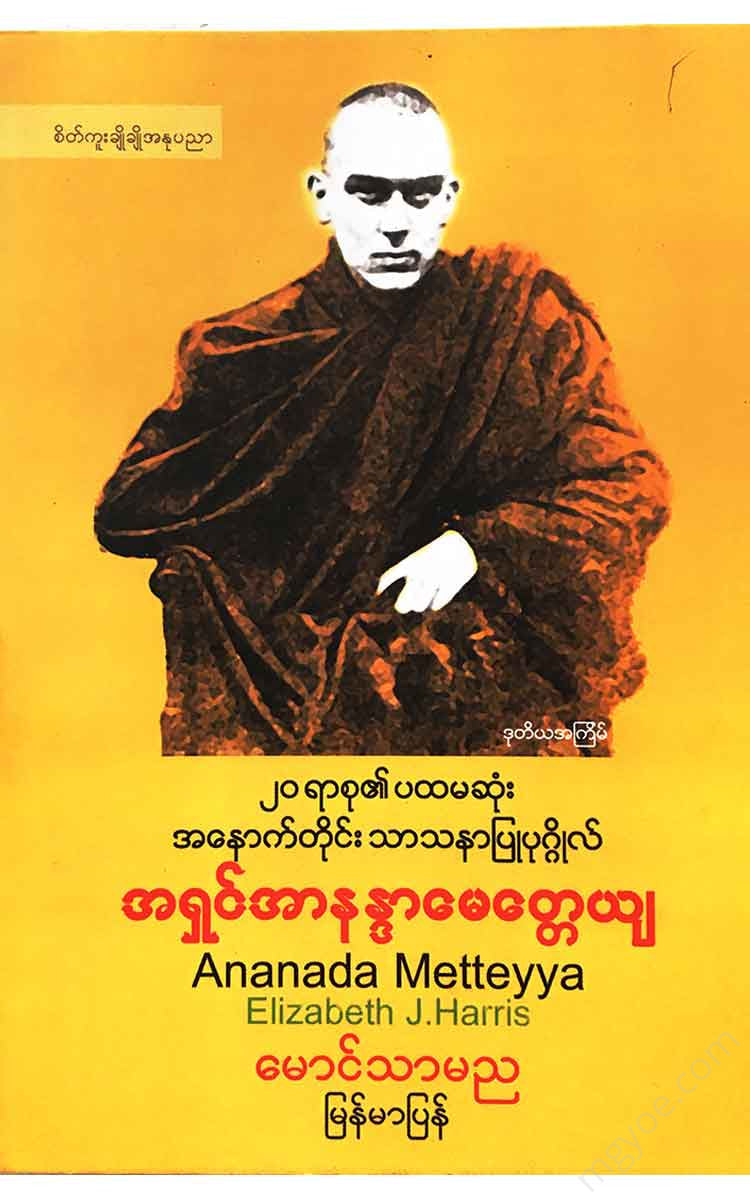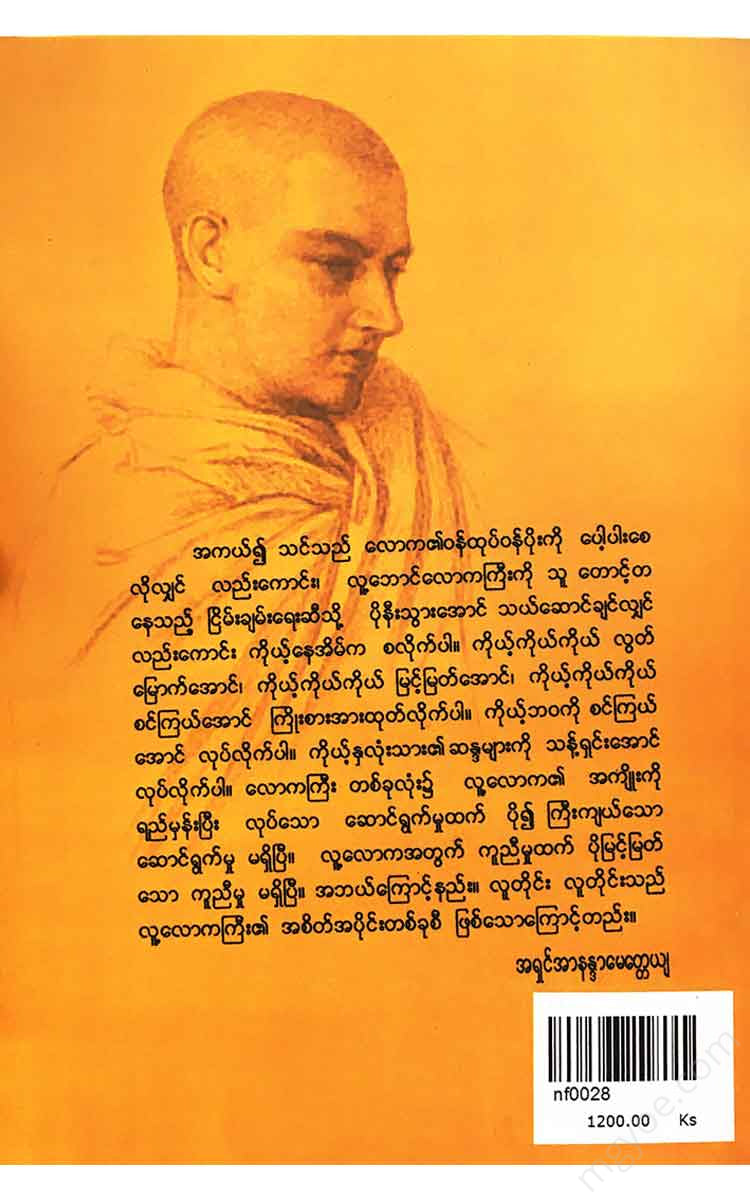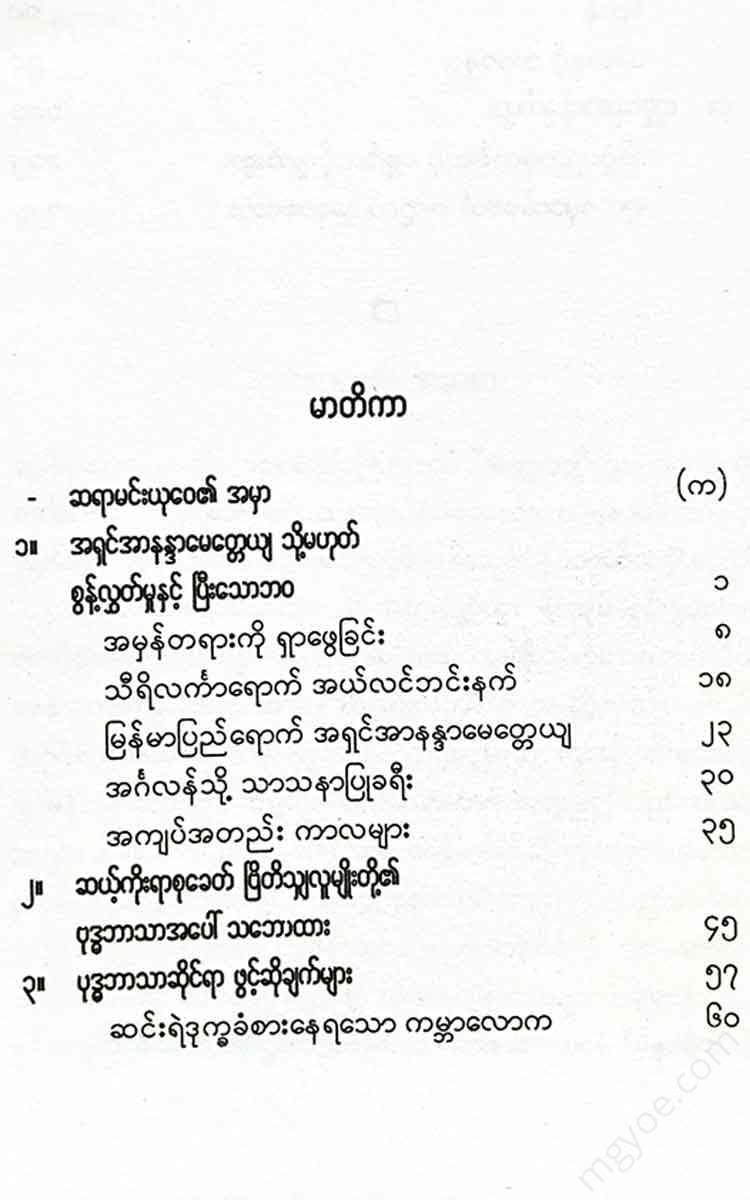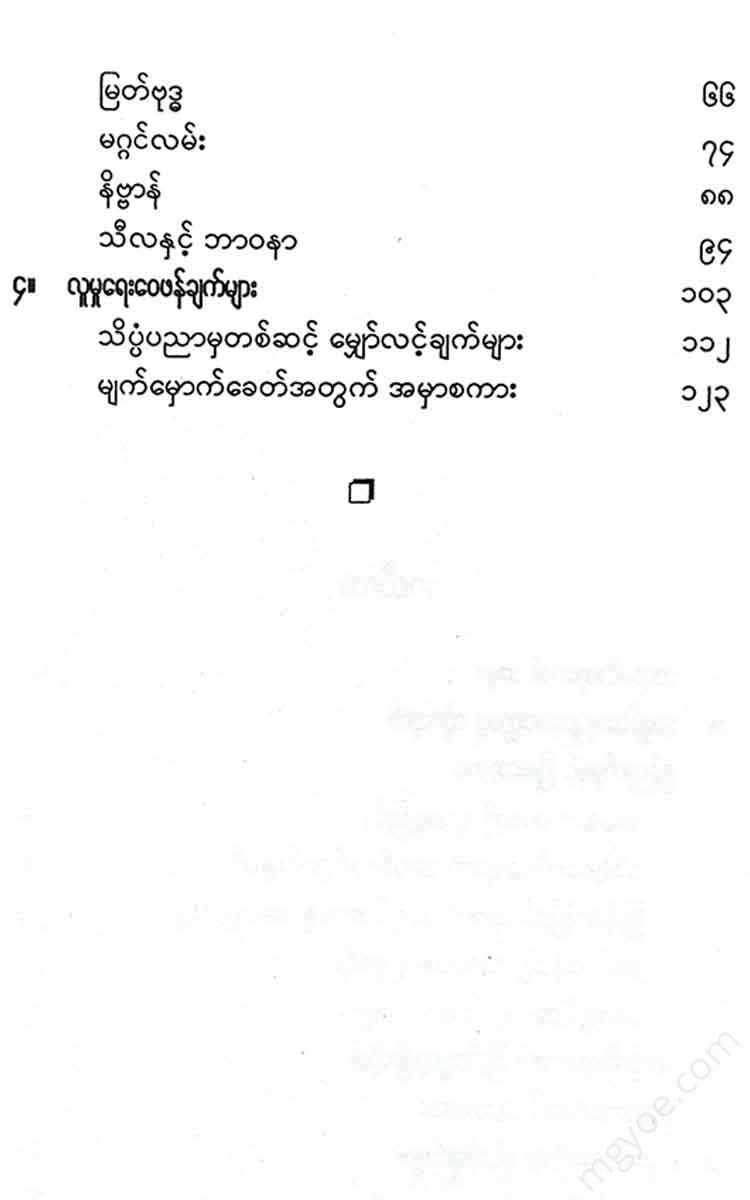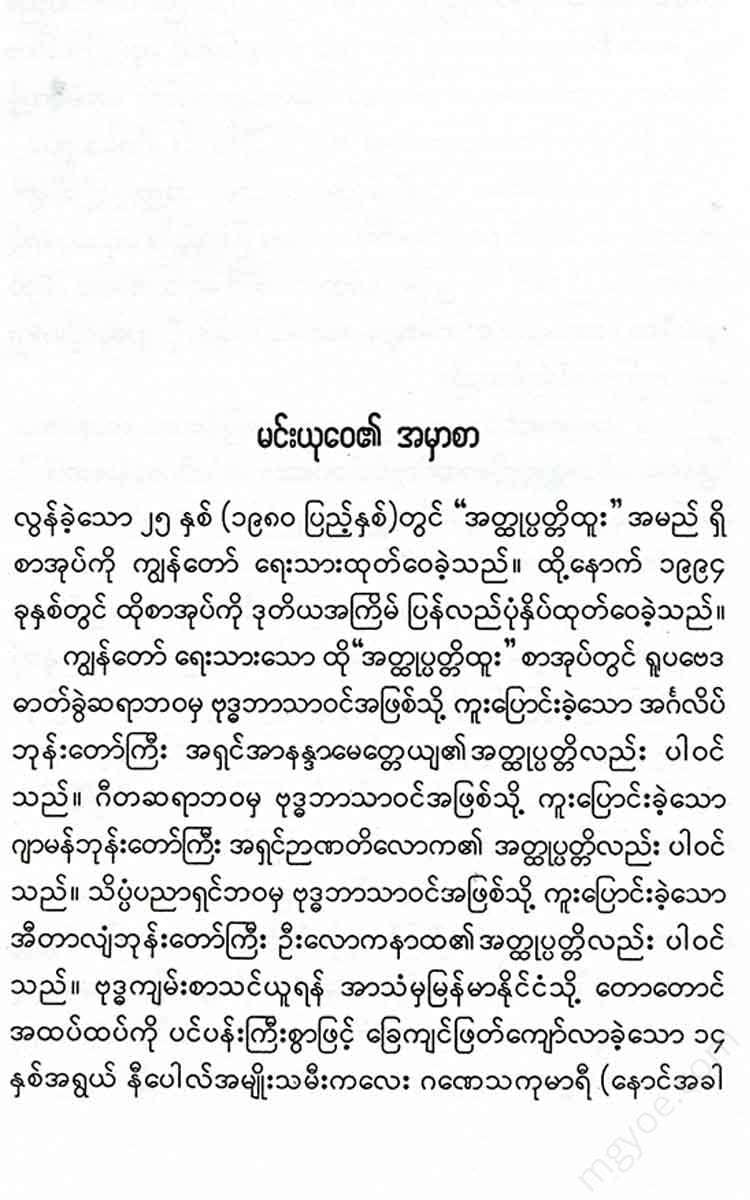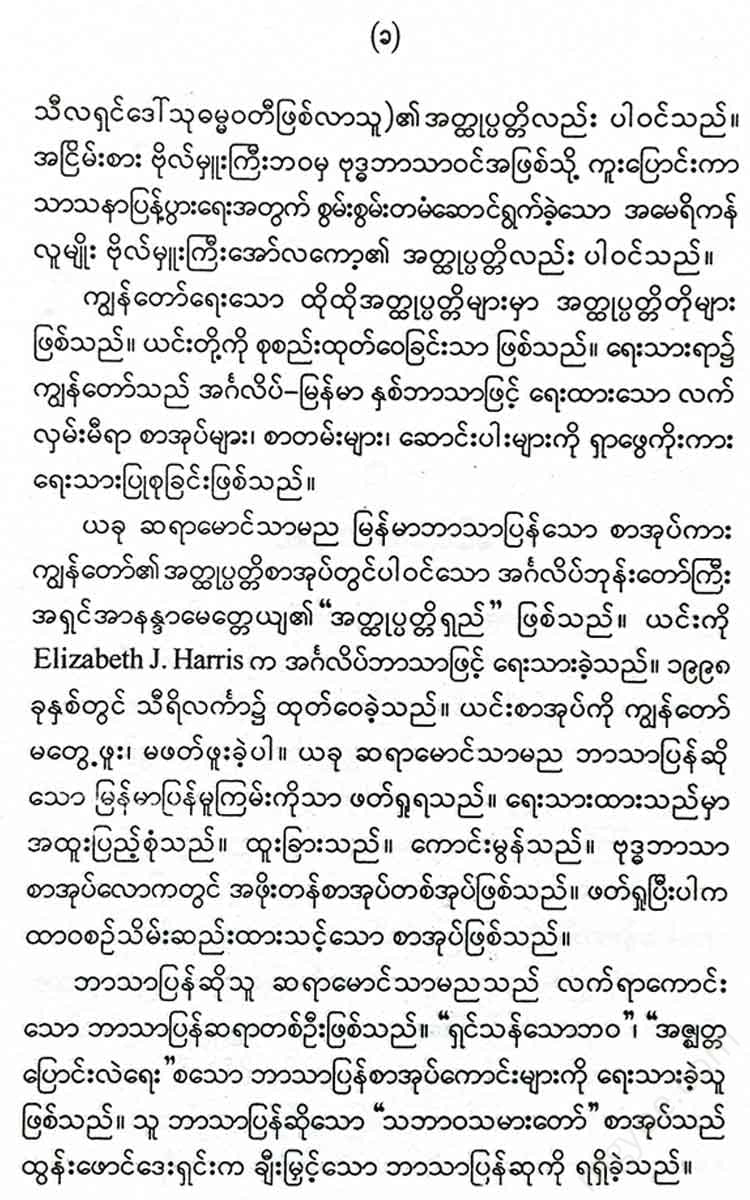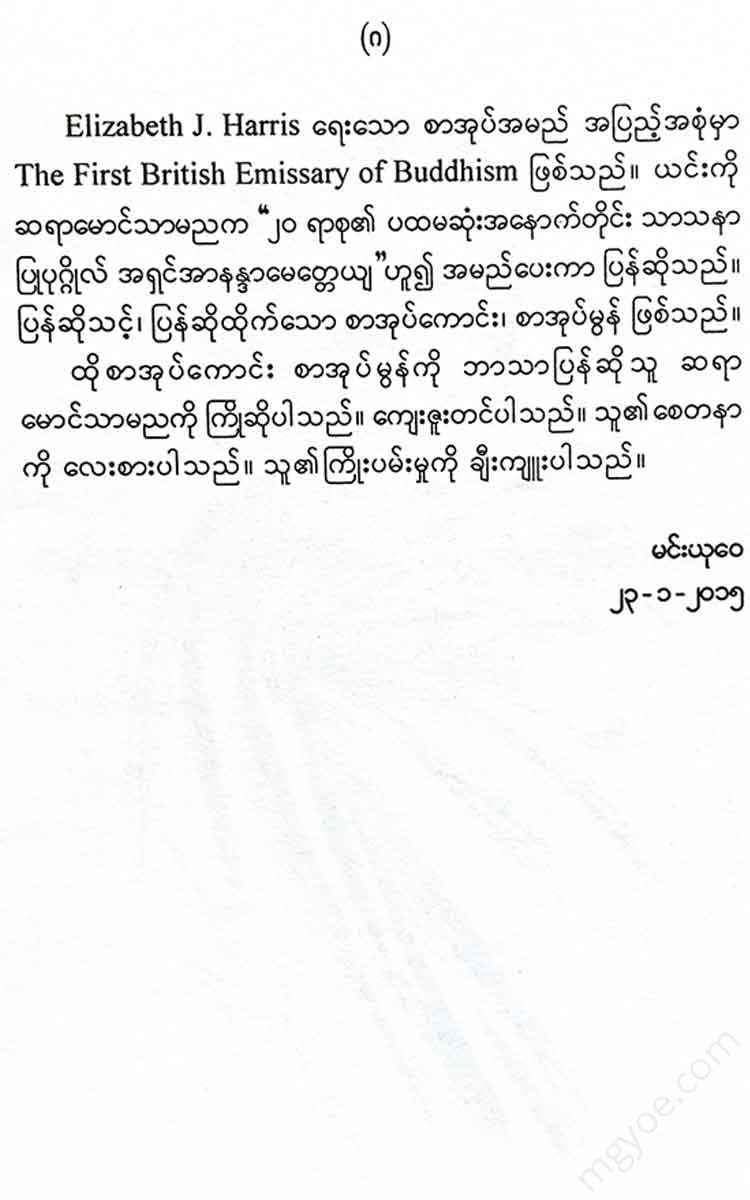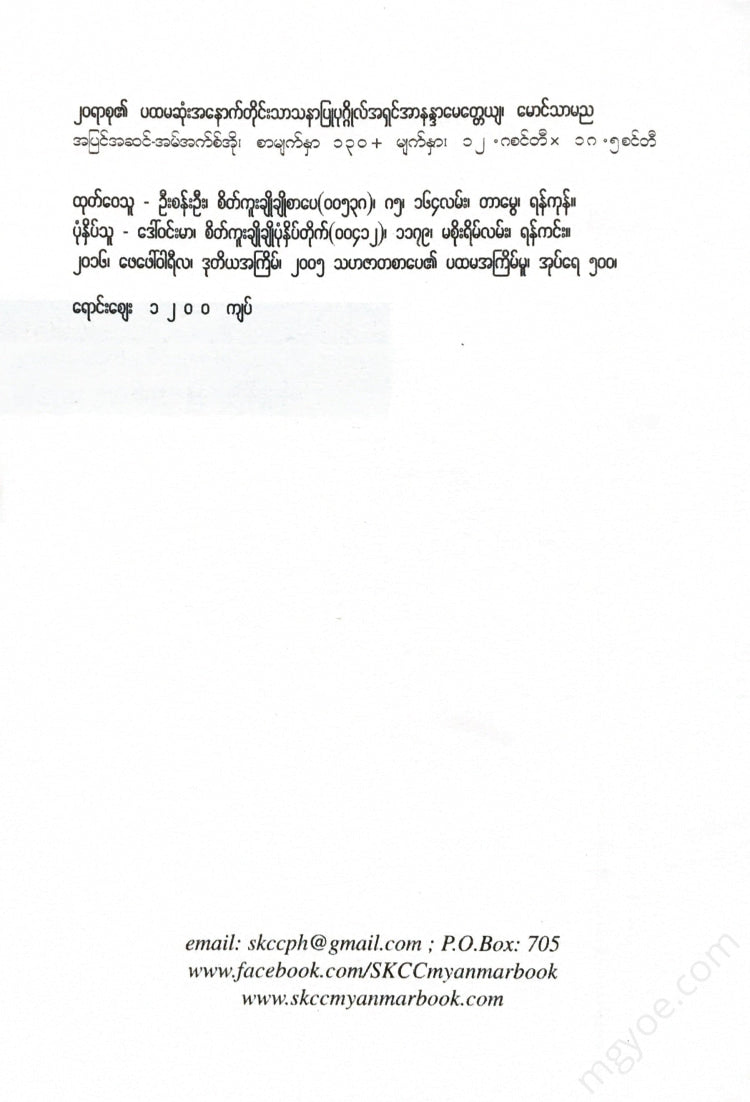စိတ်ကူးချိုချိုစာပေ
Maung Thamanya - Shin Ananda Metteya
Maung Thamanya - Shin Ananda Metteya
Couldn't load pickup availability
His face was the most unique of all the faces I had ever seen. His face was wrinkled and lined from twenty years of illness. On that face, the loving-kindness meditation practice he had cultivated throughout his life revealed a unique personality. His skin was a beautiful brown. His eyes were the soft, amber color. What was most unique was the subtle, luminous aura that radiated from his body. This aura was the light emanating from his inner self, and it permeated his individual personality. I felt this aura the first time I met him. I felt it every time I met him.
The painter and playwright Clifford Bax wrote the following after meeting Ananda Meitei in 1918. Ananda Meitei, a frail man who had suffered from asthma for many years, had by then taken off his robes and was changing into a layman. He had abandoned the monastic title of Ananda Meitei and taken back the lay name of Allen Bennett.
Ten years earlier, he had led the first missionary journey from Burma to England as Venerable Ananda Maitreya. In preparation for this journey, he had also formed the Buddhist Association of Great Britain and Ireland. He was not, in fact, the first British convert to Buddhism, but only the second. However, his influence on Buddhism in Britain in the first decades of the twentieth century was enormous.
Allen Bennett was a controversial figure during his lifetime. In 1894, he joined the Haremist Gandharic order called “The Golden Dawn.” The aim of the order was to achieve spiritual progress through the secret teachings of Gandharic. Allen Bennett gained fame as a magician and a prominent Gandharic figure. This fame did not completely disappear even when he converted to Buddhism a few years later.
In the early twentieth century, Western Buddhists held him in high regard. But as he grew older, his asthma worsened and he became completely dependent on medicine. This led to his becoming increasingly isolated from the public. A 1916 issue of the Buddhist Review, published by the Buddhist Association of Great Britain and Ireland, described his health as very poor. He managed to give a few lectures in 1917 and 1918. When he died in 1923, he was honorary secretary (temporary) of the Buddhist Association. Yet, Allen Bennett's last years were marked by poverty. Clifford Forbes wrote the following in the conclusion of his 1918 article:
Allen Bennett was a very active and intelligent person when he was a Buddhist monk. But in the middle of a life of poverty, unknown and unknown in London, he was a very old man. When Allen Bennett was about to put on his coat, his friend Menagun said that it was full of bugs. He said this because he saw that the coat that Allen Bennett was going to wear was covered in bugs that were eating the fabric.
Then Ellen Bennett replied, "They are very beautiful little worms. One day, Minagun, I will buy you a new coat. It is full of holes." Ellen Bennett replied, with a double meaning, "As you know, I am considered a nobleman, am I not?"
In English, a hole is called a "hole" and "a holey " is called "noley." "Holy" is called "holy," and the two words sound alike. Therefore, when Ellen Bennett says "a holy man," he also means "a holey man."
Ellen Bennett was buried in Mauden Cemetery, but no headstone was erected. His lifelong friend, Dr. Cassius Pereria, wrote:
Now the great worker has laid down the burden of this life. He is not only happy about this, but also sad. Because the great worker is very tired. His broken body can no longer keep up with the spirit of the active one. He introduced Buddhism to the West. He made great efforts to introduce it by publishing pamphlets, journals, and lectures. He wrote and preached with skill, full of active thought, and with an inimitable and beautiful style. The results that have come about are encouraging to those who see it.
Allen Bennett was a noble man. His deep feeling, his fervent faith, his intense concern for the spread of Buddhism in the West are evident in his writings. He combined poetic imagination, scientific spirit, and a concern for justice and peace. He was able to bring the Buddhist path to life. In doing so, he did more through writing than through preaching.
This book attempts to bring the ideas of Ellen Bennett to life. It examines his life and critiques them in historical context. It then explores his worldview and his Buddhist opening. It shows how his ideas developed during the horrors of World War I. Finally, it discusses how his writings are relevant to today.
It has been two generations since the death of Ananda Metheya. After so long, it would be impossible to reproduce his thought in its original form. In compiling this book, I have drawn mainly on his books and papers published in England and Burma, his personal letters, and the writings of his contemporaries in Sri Lanka and the West.
No biography is, after all, objective. A biography is as much a reflection of the biographer as it is a reflection of the biographer. Ellen Bennett, also known as Ananda Mettaya, would shy away from any attempt to write about him definitively. Ellen Bennett was a man of his time. He was born at the height of the British Empire. At that time, the desire to explore new religious paths gripped the hearts of many young people. Nevertheless, the author believes that the ideas and insights that Ellen Bennett presented are still relevant today. Studying Ellen Bennett’s life will not only bring back a forgotten history but will also inspire the present.
Order from King Yuwei
I wrote and published a book called “At-Khat-Pat-Tihtoo” 25 years ago (1980). Then, in 1994, the book was reprinted for the second time.
The book “Attapattihutu” that I wrote also includes the biography of Ananda Maitreya, an English monk who converted from a physics laboratory to Buddhism. It also includes the biography of Nanati Lok, a German monk who converted from a musician to Buddhism. It also includes the biography of U Lokanatha, an Italian monk who converted from a scientist to Buddhism. It also includes the biography of Ganesha Kumari, a 14-year-old Nepali girl (who later became the nun Daw Sudhammavadi), who traveled from Assam to Burma, through the jungles and mountains, with great difficulty, to learn Buddhist scriptures. It also includes the biography of Colonel Olcott, an American citizen who converted from a retired colonel to Buddhism and worked tirelessly to spread the religion.
The biographies I have written are short biographies. They are just compilations. In writing, I have searched and cited available books, papers, and articles written in both English and Burmese.)
The book that Saya Maung Thamanya has now translated into Burmese is the “Long Biography” of the English monk Ananda Mettaya, which is included in my biography. It was written in English by Elizabeth J. Harris. It was published in Sri Lanka in 1998. I have never seen or read this book. I have only read the Myanmar translation draft that Saya Maung Thamanya has now translated. The writing is particularly complete. Unique. Excellent. A valuable book in the world of Buddhist books. After reading it, it is a book that should be kept forever.
The translator, Saya Maung Thamanya, is a skilled translator. He has written many good books such as “Living Life” and “Changing the Self.” His translation of “The Natural Doctor” won the translation award presented by the Tun Foundation.
The full title of the book written by Elizabeth J. Harris is The First British Emissary of Buddhism. It was translated by Saya Maung Thamanya under the title “The First Western Emissary of the 20th Century: Ananda Meiteya.” It is a good book, worthy of being translated.
I welcome and thank the translator of that good book, Maung Thamanya. I respect his dedication. I appreciate his efforts.
Min Yu Wai
23-1-2015
